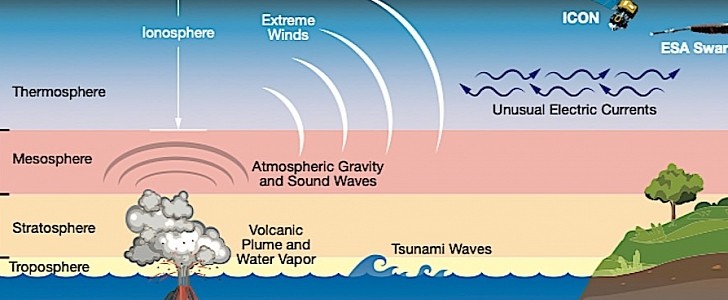2022 kicked off with a literal bang. On January 15, the Hunga Tonga-Hunga Ha‘apai underwater volcano in the South Pacific exploded, filling the skies around it with ash, shock waves and sonic booms, the waters with tsunamis, and the Internet with some of the most spectacular images ever captured on film.
The event was so massive in scale that it took scientists months to properly assess it. And now that the numbers are in, we can’t but be amazed at how powerful nature can be.
This week, NASA released some findings on the effects of the January eruption. And believe it or not, these effects expanded well beyond the borders of our planet.
NASA used data from its own Ionospheric Connection Explorer (ICON) satellite, but also ESA’s Swarm satellites, to reveal hurricane-speed winds and unusual electric currents coming to life in the atmosphere in the hours after the explosion.
As per Brian Harding, a physicist at the University of California, this was “one of the largest disturbances in space we’ve seen in the modern era.” Winds created by the eruption expanded in the upper atmosphere, reaching the ionosphere (extending from 37 to 190 miles/ 48 to 305 km above the surface), and reaching speeds of 450 mph (724 kph).
That value is the strongest below the 120 miles (space officially starts at 60 miles) altitude measured by ICON since its launch in 2019. Winds were so powerful that they affected electric currents, which normally flow to the east. As a result of the eruption “equatorial electrojet surged to five times its normal peak power” and flipped direction, moving west for a period of time.
“It's very surprising to see the electrojet be greatly reversed by something that happened on Earth's surface,” said in a statement Joanne Wu, a physicist at the University of California, Berkeley, and co-author of the new study.
“This is something we’ve only previously seen with strong geomagnetic storms, which are a form of weather in space caused by particles and radiation from the Sun.”
According to the UN, the Tonga eruption affected 85,000 people and close to 85 percent of Tonga. It officially killed three people, making the disaster here on the ground far less devastating than it could have been.
This week, NASA released some findings on the effects of the January eruption. And believe it or not, these effects expanded well beyond the borders of our planet.
NASA used data from its own Ionospheric Connection Explorer (ICON) satellite, but also ESA’s Swarm satellites, to reveal hurricane-speed winds and unusual electric currents coming to life in the atmosphere in the hours after the explosion.
As per Brian Harding, a physicist at the University of California, this was “one of the largest disturbances in space we’ve seen in the modern era.” Winds created by the eruption expanded in the upper atmosphere, reaching the ionosphere (extending from 37 to 190 miles/ 48 to 305 km above the surface), and reaching speeds of 450 mph (724 kph).
That value is the strongest below the 120 miles (space officially starts at 60 miles) altitude measured by ICON since its launch in 2019. Winds were so powerful that they affected electric currents, which normally flow to the east. As a result of the eruption “equatorial electrojet surged to five times its normal peak power” and flipped direction, moving west for a period of time.
“It's very surprising to see the electrojet be greatly reversed by something that happened on Earth's surface,” said in a statement Joanne Wu, a physicist at the University of California, Berkeley, and co-author of the new study.
“This is something we’ve only previously seen with strong geomagnetic storms, which are a form of weather in space caused by particles and radiation from the Sun.”
According to the UN, the Tonga eruption affected 85,000 people and close to 85 percent of Tonga. It officially killed three people, making the disaster here on the ground far less devastating than it could have been.








